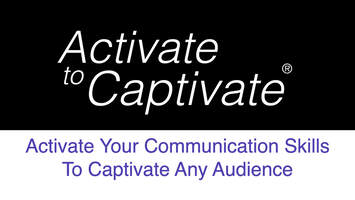|
One of the biggest anxieties presenters have is how to handle the Q & A session after a talk. With so many variables at play, it’s completely understandable that people worry about preparing for every scenario. That’s why I’ve put together these tips to help you feel confident before your next presentation.
Scenario 1: You’ve never thought about that idea before. Part of what makes presentations so wonderful is that it’s an opportunity for others to hear your ideas and share theirs. You’re not expected to have thought of every single possibility beforehand. That’s why you go to an event, to hear ideas from people with different backgrounds. If someone brings up something new you could say: “That isn’t something I’ve thought about before, but I’ll be sure to give it some consideration now that you’ve brought it to my attention.” People appreciate when you take the time to listen to their ideas, even if you don’t have an immediate answer. Scenario 2: You have no clue what the answer is. If you don’t know what the answer is, instead of worrying — just tell them the truth. You could say, “That’s a great question but not my area of expertise, so I don’t feel I can answer that right now.” It’s important to remember that you’re human and you aren’t expected to have all the answers. As long as you don’t collapse and react negatively, the audience member will appreciate that you listened to their comment. Scenario 3: You should know the answer, but can’t think of it. If someone asks a basic question, and you freeze, let the audience know. For example you could say, “That’s something I should know the answer to, but to be honest, at this moment it isn’t coming to me. I’m sure I’ll think of it right after this is over.” People understand the stress that comes with presenting. Everyone has had a moment where they blank out. Just let people know what’s happening, and then you can move on to the next question. Remember not to self-destruct when answering questions. You are human and you’re not expected to prepare for every possibility. Respond like you would if a friend asked you this question. If something surprises you, remember to breathe, state the facts, and then focus on continuing the conversation. That way, if you don’t know the answer to a question, it won’t matter. You can move on and still make a great impression. Author: Bri McWhorter Experiments don’t always go as planned and people commonly find themselves in situations where results take longer than expected. People often worry about how to present their work during a presentation, or at a conference, if they don’t have any data to show. Since people never know how an experiment will pan out, it’s important to feel confident sharing your project, even if you’re still working on it.
That’s why I’ve provided examples of phrases you can use below. If you have no data yet, you could say: We just started collecting data, and I’m looking forward to seeing the results. We are in the process of analyzing the results and I look forward to sharing our findings with you soon. We are about to run the experiment and I’ll be keeping an eye out to see if our hypothesis is correct. If you have preliminary data you could say: We are in the early stages of gathering data and at this point I’ve been seeing… We just started to get our data back and what’s popped out at me so far is… Since this is preliminary data the overall themes and takeaways may change, but so far I’m seeing… Many projects take longer than expected and it’s fine if you don’t have data or results to share. Just make sure you don’t end your presentation on that note. Instead, I recommend ending with the big picture. That way people leave your presentation thinking about the importance of your work and they can look forward to hearing what you find out next. Many people feel pressured to memorize their presentations. That’s completely understandable because if you’ve worked hard preparing a talk, you want to make sure you’re not forgetting those key ideas. However, I usually advise against memorizing a talk because when you worry about getting every word correct it can take your focus away from the main goal of the presentation — connecting to your audience. Instead of worrying about remembering every word, here are three alternative ways to prepare for a talk:
1. Change “memorize” to “familiarize” Instead of memorizing, think of it as “storytelling”. For example, when you go to a small get together, you often tell stories without practicing every word in the story. Instead, you think about how the story starts, where something changes, and specific points you want to highlight. Each time you tell this story, you realize some points you want to say a little differently or put more emphasis on. That’s how you should think of preparing for a presentation. It’s not about getting everything perfect — it’s about knowing the order of your story and certain points that will make an impact. 2. Practice key moments An audience pays the most attention during the introduction, transitions, and conclusion of a talk. Therefore, those are the parts I practice the most. If you know how you want to start your talk, how the ideas connect, and the last idea you want to share, you’ll be adequately prepared. As long as those moments are polished, you will leave the audience with a professional impression of your speech. 3. Practice without looking at the slides Most people practice presentations staring at their screen. Then, when they go to give a talk, they get thrown off because their view has changed. That’s because when you’re talking to an audience, there are far more variables to look at. Therefore, I recommend practicing in different environments. That way, when you give your talk, you’ll have an easier time remembering your content. Instead of worrying about “memorizing” a talk, think about telling a story, rehearse the main sections, and practice without looking at your slides. This way you can still feel prepared before your talk and you can focus on the main reason you’re there — to share your ideas with your audience in the best possible way. There’s a lot going on in today’s world. Sometimes anxiety and stress can be difficult to shake off. It’s even tougher when you’re feeling overwhelmed and then have to get up in front of a group and give a presentation. That’s why I find it helpful to have “reset” routines at the ready.
Here are three that have helped me in the past: 1. Watch something that makes you laugh If you’re feeling stressed or burned out, laughter is an excellent way to reset. Laughing releases chemicals in your body to help you relax and recalibrate. I personally love watching funny interviews on the Graham Norton Show or bloopers from the tv show Parks and Rec. If there’s a show or video that makes you smile and lighten up, watch it before your next presentation. That way, you can start your next speech from a positive place. 2. Do something physical When you’re stressed out, it can be challenging to stop your thoughts from going into a negative spiral. That’s why I recommend doing something physical so you shift your focus from your mind to your body. You can exercise, dance to fun music, sing your favorite song, or even just take a walk and feel the ground beneath your feet. If you bring your attention to your body, it gives you something else to focus on and think about. 3. Help someone else When life feels overwhelming, I focus on helping someone else. Helping others shifts my attention from my worries into doing something productive. As a presenter, you’re sharing information that is important for others to hear. It may make someone else’s life easier or they might learn something new. If you realize your talk could be valuable for someone else, it can help you reset and refocus. Next time you’re feeling overwhelmed, laugh, do something physical, or think about how your presentation could be helping someone else. Having things that shift your focus and reset can be incredibly powerful. And then, to be honest, there will be days that are just hard. On those days, all you need to do is realize that you’re doing your best. We are all doing our best. And as long as you’re doing that — it is enough. When people attend a virtual meeting, people log on at different moments. During that time, it can be awkward for people to sit in silence and wait for everyone to arrive. If you are facilitating a meeting where you want people to participate and speak up, this type of atmosphere is difficult to overcome. Thankfully, there are a few things you can do to make the virtual environment more engaging and dynamic.
1. Have music playing when people log on. When people log on to one of my workshops, I often having music playing for everyone to hear. This accomplishes a few things. First, it gives people something to talk about and connect over when they first enter the meeting. Second, if people’s cameras are off, the meeting still feels like it has energy and momentum. Finally, if you’re playing fun music, I’ve seen people start to move to the beat or sing along, which instantly adds in a bit of fun at the start of a meeting. If people are enjoying themselves and in a good headspace before a meeting, it’s much easier to collaborate and work together. 2. Have people use a themed virtual background. If you want to add in some creativity to a meeting, ask people to download a virtual background with a specific theme. Especially if your team is working from home, this adds some appreciated visual variety to people’s screens. You could have people put up a background of — Ideal travel backgrounds Japan, Barcelona, Disneyland, etc — Favorite tv show backgrounds Simpsons couch, the Friend’s coffeehouse, Parks and Rec office, etc — Picture of people’s favorite hobby Yoga studio, garden, kitchen, etc Not only is it fun for people to think about what background they could use before the meeting, it also allows your team to bond and share a bit about themselves in an easy and engaging way. 3. Have people share an “uninteresting fact” about themselves. Many people dread ice-breakers because they have to think of something interesting to say. That’s why one of my favorite ice-breakers is to ask people to introduce themselves and reveal an “uninteresting fact” about themselves. It can be anything from “My front door has red trim” to “My cat is sitting next to me” to “I had cereal this morning for breakfast.” By saying an uninteresting fact, people instantly start to open up without the added pressure of having to come up with something profound to share. The point of an ice-breaker is to help people open up around each other. So whether you’re playing music, having people show up with fun backgrounds, or sharing a bit of easy information about themselves, think about ways to help your group relax and connect. Your voice is an incredibly powerful tool. It’s especially important since most people are conducting their meetings virtually where they can’t rely as heavily on using body language to communicate. That’s why having a clear and strong voice is critical. However, when you’re in back to back meetings it’s easy for your voice to get tired. Therefore, here are three ways to help you avoid vocal fatigue:
1. Warm up your voice beforehand People know how important it is to warm up their body before doing a physical activity, but they don’t often think about warming up their voice before speaking. That’s why I spend at least a few minutes before I teach my workshops warming up my voice. I like to blow through my lips, spend some time humming in different pitches, and I move around a bit so I am breathing deeply and fully. That way I know my voice will be ready to use when I speak up in a meeting. 2. Sit up tall If you’re attending multiple meetings, it’s easy for your body to melt into a “schlump” where your shoulders are crouched over and your head is tilted back. This collapsed position is very hard on your voice because you’re collapsing your voice box and inhibiting your breathing. Therefore, I recommend either coming to the edge of your seat and sitting up tall, or standing as you present, if you are going to be talking for a while. That way your physical stance will keep you supported. 3. Avoid clearing your throat Many people “clear” their throats before speaking. However, that actually makes things worse. It can aggravate your throat and, overtime, cause more vocal issues down the road. Instead, I recommend humming and then swallowing. This process still clears away any mucus you have built up, but it doesn’t aggravate your throat when you do it. By warming up, keeping a tall and supported stance, and avoiding clearing your throat, you can help avoid vocal fatigue. If you listen to a lot of presentations, you’ll notice speakers often use similar phrases during their talks. Then other people hear those expressions and repeat them in their own talks. While some of these phrases are useful, here are a few phrases I’d suggest phasing out of your future presentations:
1. "To give you a little bit of background…" When people use this phrase, it subtly sends out the message, “This might not be exciting but I have to cover this information.” However, background information is often incredibly important and you want people to actively listen to it. Instead, I’d begin by jumping straight into the information. 2. "For those of you who don’t know…" This phrase can often sound patronizing and creates distance between the speaker and the audience. If you’re worried that some people in the audience don’t know this information, I’d use the phrase, “In our field it’s important to….” That way if someone does know this information they will think, “Yes, that’s true” and if they don’t know it they will think, “Oh, that’s useful.” This way you keep everyone engaged the whole time. 3. "I won’t go through all of this but…" This phrase is normally used when people have too much information on a slide. It instantly tells the audience to stop looking at the details on the slide because they might get overwhelmed. Instead I’d say, “I’d like to point out how…” That way instead of highlighting how complex the slide is, you’re helping something important stand out. By avoiding these phrases, you can easily elevate your presentations and effectively share your message with others. During a presentation, many speakers end up falling into what I call “the snowball effect” where they speak faster and faster as the presentation continues. This can be problematic for both the speaker and the audience since the speaker gets out of breath and the audience has a hard time catching all of the information. If you find yourself speeding up as you talk, here are a few tips to help:
1. Don’t connect the first few phrases you say with “and” The beginning of your talk sets the pace for the rest of your presentation. Most people end up combining their first few sentences into one long sentence with “and”. For example, “I’m Bri McWhorter and I’m from Activate to Captivate and I’m excited to share some presentation tips.” Instead, make each of those phrases independent statements. Then it comes out as, “I’m Bri McWhorter. I’m from Activate to Captivate. I’m excited to share some presentation tips.” That way you start off at a slower and more natural pace. 2. Think of your presentation as giving step-by-step instructions When people are giving instructions, they don’t speed through them. They take their time giving each one and then check in with the listener to make sure it’s sunk in. That’s what you want to do with your presentation. This is all new information and just because you’re familiar with it, doesn’t mean your audience is. That’s why you need to reveal it step-by-step so each section can be absorbed. Try practicing your transitions as instructions and see if it helps you slow down. 3. Every time you click — breathe I recommend that every time you click to a new slide, you breathe and exhale. That way, even if you do start to speed up during a presentation, you have a built-in way of slowing down. Since the audience needs a moment to take in the new visual anyway, you end up helping yourself slow down and you help the audience have a moment to absorb the new information at the same time. If you break up your first few sentences, think of revealing your presentation as step-by-step instructions, and breathe every time you click to a new slide, you can elevate your talk by slowing down a bit so your audience has time to listen and learn from your presentation. As the world opens back up again, hybrid presentations are becoming more popular. It’s a great way to give people the option of being able to participate in-person or online. However, with this format, it means the presenter has to be even more prepared in order to make a positive impact. Here are three tips to keep in mind:
1. Put your headshot on your title slide Since most in-person events require masks, this means that people online and in-person never get to see your face. That’s why I recommend putting your headshot on your title slide. That way, even though your face is covered, people can still imagine what you look like. Then, when people look you up online after your talk, or see you outside after an event, they can recognize and connect with you. 2. Face your audiences With hybrid presentations, your audience is in two places, one in front of you and one behind the camera. This can be an odd adjustment for many presenters since their tendency is to look behind them at the screen where their slides are being projected. However, when speakers do this, they often turn their backs to the camera. That means the entire virtual audience can’t see you anymore. Therefore it’s important to face out so your physical and virtual audiences can see you at all times. 3. Repeat questions After your talk, your audience will probably ask you some questions. However, since you have two different audiences, this means the virtual audience can’t hear what’s happening in the room and the physical audience can’t read the chat box. Therefore as a speaker, get into the habit of always repeating the question before you answer it. That way, the virtual audience can hear what someone asked before you launch into an answer and the physical audience doesn’t get confused when you are answering a question online. By repeating the questions, both audiences feel included and can easily follow your answers. If you add your headshot to your title slide, make sure you are facing your audiences, and repeat questions so everyone can follow what’s happening, you can easily elevate your talks for hybrid presentations. Nerves can be difficult to overcome, especially during important presentations. Nerves cause many people to stiffen up and go into what I call “Presenter mode” where their body tenses and their voice becomes more muted and monotone. Not only is this hard for the presenter, it’s also hard on the audience, because it’s difficult to listen to someone speak when they are overwhelmed by nerves. That’s why it’s important to have a few actions you can rely on to relax and feel more like yourself.
1. Think of your first word as a sigh When people start speaking they often hold their breath when they start to speak. This can make the presenter’s voice sound strained which can magnify nerves. Instead, I recommend thinking of your first word as a sigh. If you sigh as you say “Hello” or “Alright everyone, let’s begin” it will help remind your body to exhale and relax. That way, when you start speaking you sound more at ease. 2. Move your body When your body is tense, you have more adrenaline pumping through your system so you want to find active ways to remind your body that it can relax. One way is to remember how your body moves during a conversation. When you’re casually talking to someone, you move your hands when you talk and you twist your torso as you share ideas. But during a presentation, people tense up. Therefore when you're introducing yourself, move your torso and use your hands as you speak. That way you can release some of the tension that has built up to help you feel more natural. 3. Find a point of focus When people start speaking they are often trying to look all over their computer screen or at everyone in the room. This can heighten your nerves because your eye is trying to take in too much information. To help calm yourself down, I recommend finding one person to talk to. Think about putting them at ease with this next bit of information. Then, direct your attention somewhere else with your next piece of content. Finding a point of focus can help you slow down and make your speech feel more like an intimate conversation. Nerves can surprise us, so it’s useful to have a few tools to rely on to help calm yourself down. Thinking of your first word as a sigh, moving your body, and finding a point of focus will help you feel that this presentation is more like a conversation. The more conversational you feel, the more at ease you will be. |
AuthorBri McWhorter is the Founder and CEO of Activate to Captivate. Categories
All
Videos
Archives
April 2024
|
Click to Contact
© 2014-2024 Activate to Captivate, LLC
All Rights Reserved
All Rights Reserved











 RSS Feed
RSS Feed
